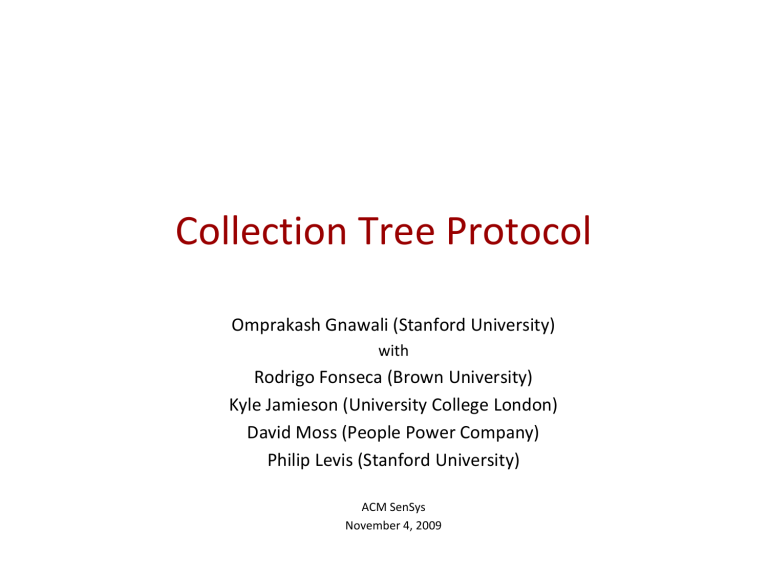PPT - Stanford Information Networks Group (SING)

Collection Tree Protocol
Omprakash Gnawali (Stanford University) with
Rodrigo Fonseca (Brown University)
Kyle Jamieson (University College London)
David Moss (People Power Company)
Philip Levis (Stanford University)
ACM SenSys
November 4, 2009
Collection
• Anycast route to the sink(s)
– Used to collect data from the network to a small number of sinks (roots, base stations)
– Network primitive for other protocols
• A distance vector protocol sink
2
Common Architecture
Control Plane
Router
Link Estimator
Fwd
Table
Link Layer
Data Plane
Application
Forwarder
3
Prior Work
Control Plane
ETX, MT,
MultiHopLQI, EAR,
LOF, AODV, DSR,
BGP, RIP, OSPF,
Babel
Link Layer
Data Plane
Flush, RMST,
CODA, Fusion,
IFRC, RCRT
4
Wireless Link Dynamics
0.9
1s
5
Control and Data Rate Mismatch
• Can lead to poor performance
Control Plane Data Plane
Link Layer
6
Control Plane
Router
Link Estimator
CTP Noe
Data Plane
Application
Forwarder
Link Layer
7
CTP Noe’s Approach
• Enable control and data plane interaction
• Two mechanisms for efficient and agile topology maintenance
– Datapath validation
– Adaptive beaconing
Control
Plane
Data
Plane
8
Summary of Results
• 90-99.9% delivery ratio
– Testbeds, configurations, link layers
• Compared to MultihopLQI
– 29% lower data delivery cost
– 73% fewer routing beacons
– 99.8% lower loop detection latency
• Robust against disruption
• Cause for packet loss vary across testbeds
9
Outline
• Collection
• Datapath validation
• Adaptive beacons
• Evaluation
• Conclusion
10
Datapath validation
• Use data packets to validate the topology
– Inconsistencies
– Loops
• Receiver checks for consistency on each hop
– Transmitter’s cost is in the header
• Same time-scale as data packets
– Validate only when necessary
11
– Cost does not decrease
Routing Loops
X
C
B
4.6
D
5.8
6.3
A
12
Routing Consistency
• Next hop should be closer to the destination
• Maintain this consistency criteria on a path n i n i+1
• Inconsistency due to stale state n k
13
Detecting Routing Loops
• Datapath validation
– Cost in the packet
– Receiver checks
• Inconsistency
– Larger cost than on the packet
• On Inconsistency
– Don’t drop the packets
– Signal the control plane
8.1
C
X
5.8 < 8.1?
5.8
D
5.8
B
4.6
6.3
A
6.3
14
Outline
• Collection
• Datapath validation
• Adaptive beacons
• Evaluations
• Conclusion
15
How Fast to Send Beacons?
• Using a fixed rate beacon interval
– Can be too fast
– Can be too slow
– Agility-efficiency tradeoff
• Agile+Efficient possible?
16
Routing as Consistency
• Routing as a consistency problem
– Costs along a path must be consistent
• Use consistency protocol in routing
– Leverage research on consistency protocols
– Trickle
17
Trickle
• Detecting inconsistency
– Code propagation: Version number mismatch
– Does not work for routing: use path consistency
• Control propagation rate
– Start with a small interval
– Double the interval up to some max
– Reset to the small interval when inconsistent
18
Control Traffic Timing
• Extend Trickle to time routing beacons
• Reset the interval
• ETX(receiver) >= ETX(sender)
• Significant decrease in gradient
• “Pull” bit
TX
Increasing interval Reset interval
19
Adaptive Beacon Timing
~ 8 min
Tutornet
Infrequent beacons in the long run
20
Adaptive vs Periodic Beacons
1.87
beacon/s
Tutornet
Time (mins)
Less overhead compared to 30s-periodic
0.65
beacon/s
21
Node Discovery
A new node introduced
Tutornet
Path established in < 1s
Time (mins)
Efficient and agile at the same time
22
Outline
• Collection
• Datapath validation
• Adaptive beacons
• Evaluation
• Conclusion
23
Experiments
• 12 testbeds
• 20-310 nodes
• 7 hardware platforms
• 4 radio technologies
• 6 link layers
Variations in hardware, software, RF environment, and topology
24
Evaluation Goals
• Reliable?
– Packets delivered to the sink
• Efficient?
– TX required per packet delivery
• Robust?
– Performance with disruption
25
Kansei
CTP Noe Trees
Twist
Mirage
26
Reliable , Efficient, and Robust
Testbed
Wymanpark
Vinelab
Tutornet
NetEye
Kansei
Mirage-MicaZ
Quanto
Blaze
Twist-Tmote
Mirage-Mica2dot
Twist-eyesIFXv2
Motelab
Delivery Ratio
0.9999
0.9999
0.9999
0.9999
0.9998
0.9998
0.9995
0.9990
0.9929
0.9895
0.9836
0.9607
High end-to-end delivery ratio
(but not on all the testbeds!)
False ack
Retransmit
27
Reliable , Efficient, and Robust
0.98
Tutornet
5 10 15 20 25 30 35
Time (hrs)
High delivery ratio across time
(short experiments can be misleading!)
28
Reliable, Efficient , and Robust
Tutornet
Low data and control cost
CTP Noe
29
Reliable, Efficient , and Robust
1
0.8
0.6
0.4
0.2
0
Motelab, 1pkt/5min
CSMA
0.028
0.066
BoX-1s
Link Layer
LPP-500ms
Low duty-cycle with low-power MACs
30
Reliable, Efficient, and Robust
10 out of 56 nodes removed at t=60 mins
Tutornet Time (mins)
No disruption in packet delivery
31
Reliable, Efficient, and Robust
Nodes reboot every 5 mins
Routing Beacons
~ 5 min
Tutornet
Delivery Ratio > 0.99
High delivery ratio despite serious network-wide disruption
(most loss due to reboot while buffering packet)
32
CTP Noe Performance Summary
• Reliability
– Delivery ratio > 90% in all cases
• Efficiency
– Low cost and 5% duty cycle
• Robustness
– Functional despite network disruptions
33
Acknowledgment
For testbed access and experiment help
• Anish Arora
• Geoffrey Werner Challen
• Prabal Dutta
• David Gay
• Stephen Dawson-Haggerty
• Timothy Hnat
• Mukundan Sridharan
• Matt Welsh
• Kamin Whitehouse
• Hongwei Zhang
For bug reports, fixes, and discussions
• Ki-Young Jang
• Xi Ju
• Andreas Köpke
• Razvan Musaloiu-E.
• Vinayak Naik
• Rajiv Ramnath
• Mehmet Akif Antepli
• Juan Batiz-Benet
• Jonathan Hui
• Scott Moeller
• Remi Ville
• Alec Woo
• and many others…
Thank You!
34
Conclusion
• “Hard” networks → good protocols
– Tutornet & Motelab
• Wireless routing benefits from data and control plane interaction
• Lessons applicable to distance vector routing
– Datapath validation & adaptive beaconing
Data trace from all the testbeds available at http://sing.stanford.edu/gnawali/ctp/
35





